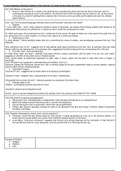A-Level Literature: Revision Guide for Holy Sonnet 3 (O might those sighs and tears)
AO1: BIG IDEA(s) of the poem?
● Donne’s ‘Holy Sonnet III’ is rooted in the grief that he is experiencing about what he has done in the past, and it is
consequently causing him pain in the present. He feels that God is the only figure that can help him out, as this sonnet
is the start of a chain of wanting God to cleanse him of his sins, so he can climb up the ladder and reach his ultimate
goals (heaven)
AO2: Top 5 form/structure/language methods used to communicate meaning to the reader?
1. Realism
“I must suffer pain.”- short, sharp sentence creates a sense of bluntness, we witness Donne being realistic with himself as he
understands that because he suffered sin, it means he has to suffer the consequence of pain
“th’ effect and cause, the punishment and sin”- ending line to the sonnet, the grief he feels now is the result of the grief from his
sin, almost like he’s in a trap of grief or a vicious cycle, where it’s a continuous feeling
2. References to God
“in mine idolatry”- Donne explicitly states that he is committing the crime of idolatry, and worshipping someone that isn’t God
{disloyal}
“that sufferance was my sin”- suggests that he was getting upset about something more than God, as perhaps God has made
Donne suffer by not cleansing him of his previous sins, suggesting that God is being sinful by not cleansing him of his sins
3. The Title, Form, Tone and Structure
“O might those sighs and tears”- explicitly showcases Donne’s coping mechanism with the grief of his sin, the verb “sighs”
suggests an element of discontent and an irritated manner
Form- lament poem {a passionate expression of grief, often in music, poetry and the grief is most often born of regret, or
mourning}
Tone- the poem has a pragmatic {understanding and realistic} tenor to it
Structure- follows the Petrarchan sonnet form, with a rhyming couplet at the end, enjambment used to convey isolation, caesura
used to reflect Donne’s thinking process
4. Hyperbolic Imagery
“mourned in vain”- suggests that he wants there to be physical manifestation
“showers of rain”- metaphor that is representative of his tears, melodramatic
“What griefs did my heart did rent?”- rhetorical question to emphasize his broken heart
5. Different types of sin
“idolatry”- worshipping someone else that isn’t God
“drunkard”- person that is frequently drunk
“lecher”- given to sexual indulgences {could be the ultimate root of his previous sins} ONE OF THE 7 SINS
AO3: RELEVANT contextual considerations?
● Petrarchan Lover- stereotypically a melodramatic male that gives themselves to an unrequited love
● Belief that frequent sexual intercourse led to a shorter life expectancy
● Sexual intercourse was for procreation rather than sexual gratification
● Written after Donne’s apostasy, perhaps he wants to be cleansed of his sins from being a Catholic, before he becomes
the Dean at St Pauls
AO5: Possible interpretations and/or useful critical quotations?
● Feminism- would like that Donne being an “itchy lecher” is being recognised as a sin, as in his previous poems, it is
known that his sexual desires can cause unfair treatment towards women {in the Flea}
● Louis Martz- “temporary conclusion” suggests that Donne’s sins will get cleansed as the conclusion in Holy Sonnet III
{the punishment and sin} is just temporary, and this punishment he is receiving will soon go
Possible THEMES?
● Religion
● Realism
● Sins





